NorthEast Radio Watch 12/8/2025: Cichon’s Back in Buffalo
In this week’s issue… Veteran newsman returns - Remembering NY's Leitner, RI's Jones - CT AM saved - Maine AM moves - "Indie" adds suburban signals
As Mike Fitzpatrick of NECRAT.us has noted in a comment on an earlier installment in our ongoing recap of a very action-packed June 2010 trip to broadcast facilities up and down New York’s Hudson Valley, two determined tower-hunters can see a lot of sites in just three days, if they put their minds to it and the weather cooperates.
It helps, too, to have local engineers excited about showing off their sites – and we found a lot of those in the valley, happy to take us inside interesting stations like Newburgh’s WGNY.
WGNY is the oldest continuously-operating radio station between Albany and New York City, dating back to 1933, but it’s been going through some big changes lately: a new AM transmitter site, a call change to its FM sister, another new FM sister up the valley, and the end of a long-running LMA that brought the station’s programming to listeners in the Port Jervis area where New York, New Jersey and Pennsylvania all come together along the Delaware River.
We’ll get to all those changes, but we start at the WGNY studio building at 661 Little Britain Road (NY 207). In 1958, WGNY (then a daytimer on 1220) moved from its studio on Broadway in downtown Newburgh, hard by the west shore of the Hudson, to this cobblestone building in a leafy area west of the city (and on the way to the brand-new New York State Thruway another mile to the west.) The building is still there, with offices on the main floor and the studio core down in the basement, where we find a row of studios looking out to a sort of lounge area, with a small rack room tucked away under the stairs.
When we visited in June 2010, there were two program streams coming out of here: “Fox Radio,” the adult contemporary format on WGNY-FM (103.1) and Port Jervis’ WTSX (96.7), and “Fox Oldies,” an oldies format on WGNY (1220) and Port Jervis’ WDLC (1490) – and also on 103.1’s HD2.
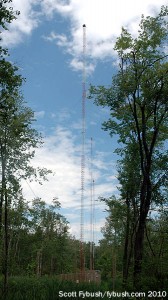
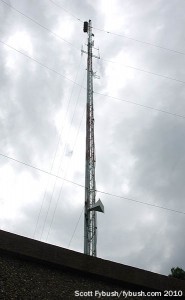
Before we get into the HDs and the FMs, let’s take a look at WGNY(AM), a station that’s done a lot of moving around to get where it is now.
Until the 1990s, WGNY’s transmitter site was across Lake Washington, just half a mile or so north of the studios. But that site succumbed to development, sending WGNY to a temporary location in a lumberyard adjoining I-84 that remained in use until 2007, when the current three-tower site near Orange Lake, two miles northwest of the old site, was completed.
Along the way, WGNY bounced around the dial, too: around 1989, the station was granted special temporary authority to relocate from 1220 to 1200, where it hoped to take advantage of the breakdown of the clear channels to make a permanent home. Other stations wanted the channel, too, of course – and in the end it was the move of WKOX (1200 Framingham MA) into Boston that won priority on the channel, sending WGNY back to 1220. The station at least got more power out of the shuffle: it moved out to Orange Lake as a 5 kW day/180-watt night facility, but subsequently boosted day power to 10 kW.
The new site on Rock Cut Road had to be built around some pretty hefty environmental obstacles, preserving trees and wetlands and avoiding the airspace of nearby Stewart Airport, so these towers take “low-profile” to the extreme: you’ve got to get right up on the site to even see them back here.
The transmitter building is a prefab enclosure, the towers are top-loaded, and in lieu of a traditional ground system there’s a system of elevated radials around each tower base.
(One more note about that 1200 frequency: Joergen Klebe, owner of WGNY’s parent company Sunrise Broadcasting, didn’t give up easily on the channel. After WGNY was kicked off 1200, Klebe was granted a series of construction permits to use 1200 further north. Using the callsign WJGK – his initials – Klebe’s 1200 CPs proposed operation in both Highland, near Poughkeepsie, and Kingston. In the end, they all expired unbuilt.)
The story of WGNY’s sister FM station is a little simpler. WFMN (103.1) signed on in 1966 as an independent FM at a time when that was still a difficult business proposition. By 1974, it had come under common ownership with WGNY, and by 1985 it had the WGNY-FM calls.
The 103.1 tower site is also near Stewart Airport, west of Newburgh. Its tower sits near the corner of Little Britain Road and Toleman Road, just southwest of the airport, and inside the transmitter building there’s a fairly new BE transmitter to handle the HD signal. For Sunrise, HD has been part of an interesting expansion strategy: not long after we visited in 2010, WGNY-FM on 103.1 became WJGK, freeing up the WGNY-FM calls to be used on a new signal Klebe had bought at auction. The new 98.9A in Rosendale, south of Kingston, signed on as WGNY-FM in 2011; it carries the same “Fox Oldies” format heard on 1220. Then there’s “Fox Drive FX,” a dance-music channel that’s now on 98.9 HD2, 103.1 HD2 and several translators, including the 95.7 translator on the “Walker Tower” near Poughkeepsie that we showed you last week.
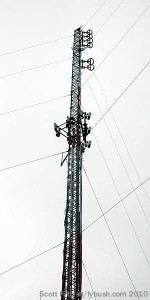
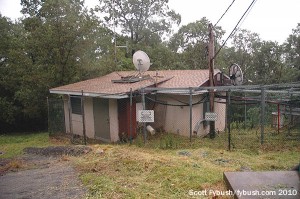
Just across the Hudson from Newburgh is Beacon, a once-depressed industrial city that’s finding new life as an artists’ enclave. We showed you Mount Beacon on the cover of our 2011 calendar and in a 2010 Tower Site of the Week segment, but that’s not the only broadcast facility in town.
The four towers of Pamal’s WBNR (1260) are on South Avenue, along the banks of the Hudson just south of downtown Beacon. WBNR’s studios were once here, too, as were studio facilities for sister station WSPK (104.7), which transmits from up on the mountain. Today, those studios are over in suburban Fishkill and the old studio building here is, if memory serves, a day-care center.
Moving south from Newburgh and Beacon, we cross into the outer reaches of the New York City market. Peekskill sits along the Hudson’s east bank at the northern edge of Westchester County.
WLNA (1420 Peekskill) simulcasts with WBNR as part of the “Hudson Valley News-Talk Network,” which also includes WGHQ (920) up in Kingston. Like WGNY, the WLNA site is very well camouflaged, sitting down by Peekskill Hollow Creek, a tributary of the Hudson that runs just north of Peekskill. Looking through the trees from Dogwood Road, we can see only parts of the five-tower array through the trees – and the transmitter building is even better concealed. (As you can see over at NECRAT, it’s actually one bay of the garage of a ranch house around the corner!)
The longtime studios of WLNA and sister station WHUD (100.7) were just up Dogwood Road, on a steep little street called Radio Terrace; the stations now operate from Pamal’s Fishkill studios along with WBNR and WSPK.
The big signal of WHUD comes from just across the Putnam County line as we head north. The southernmost full class B commercial signal in the Hudson Valley (the others are WSPK on Mount Beacon and WPDH on Illinois Mountain), WHUD started out in 1958 as WLNA-FM, using a channel that had been vacated by an early standalone FM signal over in New Haven, Connecticut, WBIB-FM. (WLNA had originally requested 106.7, the channel that would later go to New York City as WRVR and eventually become today’s WLTW.)
From its 393-foot tower up here at the end of Sky Lane, WHUD’s 50 kW signal reaches south to the city and north past Poughkeepsie; the newly-created “Hudson Valley” Arbitron market is widely believed to have been created based on this signal’s core coverage area of Westchester, Rockland, Putnam and Orange counties.
And what a signal it is! Pamal recently rebuilt this site, installing four Nautel V10 transmitters in parallel. That somewhat unusual configuration provides one huge advantage: WHUD doesn’t need auxiliary transmitters – if one of the V10s fails or needs servicing, the station chugs along at nearly full power from the remaining transmitters.
It’s a beautiful installation, and a nice place to say goodbye to the lower Hudson Valley. In next week’s concluding installment of our June 2010 travels, we’ll jump up to the valley’s northern end and show you the signals of Hudson and Catskill.
Thanks to Bill Weeks and Dave Groth for the tours!
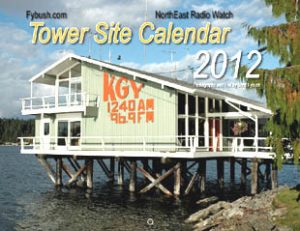 It’s not too late to order the all-new Tower Site Calendar 2012, still available from the all new Fybush.com store!
It’s not too late to order the all-new Tower Site Calendar 2012, still available from the all new Fybush.com store!
And don’t miss more Hudson Valley IDs next Wednesday, over at our sister site, TopHour.com!
Next week: Hudson and Catskill, 2010
In this week’s issue… Veteran newsman returns - Remembering NY's Leitner, RI's Jones - CT AM saved - Maine AM moves - "Indie" adds suburban signals
In this week’s issue… Scripps stations face takeover - Sinclair moves more affiliations - CT stations sold - Maine AM surrendered - Remembering WVBR's Shapiro, WABC's Morgan
In this week’s issue… CT TV legend succumbs to cancer - Remembering PA's Adams - FCC still stalled by shutdown - Pittsburgh morning host exits
In this week’s issue… FCC faces reopening challenges - Veteran Boston anchor retires - Morning shift in Toronto - NYC FMs expand reach